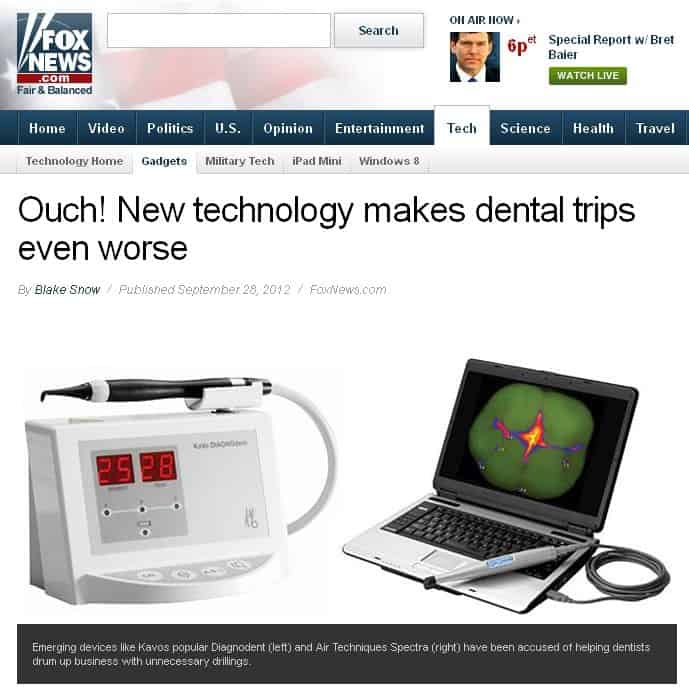Maybe you, too, saw this headline a while back:

It made a lot of us here in the office say “ouch!” – but not for the reasons the journalist responsible probably had in mind. It was a horrible representation of what modern dentistry offers – and of a not-so-new technology that offers a great service when used properly.
The inspiration for the article was a paper published this past summer in Caries Research on whether “adjunct methods” such as x-rays and laser fluorescence “improve the detection of primary molar lesions in comparison to visual inspection alone.” The authors concluded that they don’t.
But while the Fox News report is correct in saying that “experts” are concerned that the diagnostic tools may be “easily abused” and “lead to unnecessary dental surgery,” they don’t make it clear that proper use of such tools can actually help ensure against aggressive overtreatment.
Part of this may stem from the fact that the main dental expert consulted was an American Dental Association spokesperson, Matthew Messina. Forgive us if we struggle with taking expert, patient-protecting advice from an organization that still promotes mercury fillings and root canals as perfectly safe.
“We can do excellent dental work with traditional X-ray, visual, and hand exams alone,” said Messina. Traditional x-ray? Seriously?! Digital x-rays reduce radiation exposure by 90%. “I want to put things in my office that really make us better,” Messina added. Digital imaging equipment would be a start.
Before beginning the Caries Research study, the researchers hypothesized that adjunct diagnostic methods probably wouldn’t help a lot “due to the current low caries prevalence in most countries.” Interestingly, however, a presenter at the recent ADA conference suggested that this fact argues for using laser fluorescence detectors like Diagnodent and Spectra.
As oral health has improved through the use of fluoridated water and varnish applications, Dr. Flucke said he’s seen fewer “bombed out” teeth, making it harder to detect caries or “silent” areas of decay.
Studies have shown that only 24% of caries are discovered by probing for stickiness, Dr. Flucke said, adding that some dental schools no longer even teach sharp explorer diagnosis. He described a recent case in which one of his patient’s teeth looked healthy but turned out to have caries that were 6- to 7-mm deep when he excavated it.
He evaluated two classes of devices: those using probes (KaVo Diagnodent and Midwest Caries I.D.) and those using visuals (Air Techniques Spectra and Acteon Soprolife).
The KaVo Diagnodent uses a 655-nanometer (nm) diode laser to measure caries fluorescence with digital and audible diagnostic indicators for immediate feedback. This helps dentists be more conservative in their treatment decisions.
Dr. Flucke said he tries to save teeth whenever possible. “I’m a John Lennon fan and my motto is: Give teeth a chance.”
And it could be ours, as well. For here’s the bottom line: When used properly, Diagnodent and similar tools are an aid in diagnosing and conservative treatment planning.
Messina said it’s important to remember that teeth can sometimes repair themselves over time with flossing, brushing, and fluoride treatments at home.
Minus the fluoride, absolutely true.
And since regular dental exams can keep a close eye on any areas of concern, treating teeth based on a positive fluorescence diagnosis alone could be premature — a solution looking for a problem.
And that’s exactly why we never rely on fluorescence alone. To paraphrase Dr. Flucke, we don’t use the devices to make decisions for us. They enlarge the picture so we can get a better view in the context provided by digital imaging, visual exam and probing.
Dr. Glaros has used Diagnodent in this way for more than a decade. It’s allowed him to “follow” many lesions with a precision that would be impossible to do with just an explorer. Using the technology and a conservative approach, we “read” the numbers and use a diagnosis protocol that interprets the readings differently based on a patient’s age, historical rate-of-caries, plaque control and frequency of dental appointments for re-checking the questionable lesions.
Let’s not throw out the baby with the bathwater.